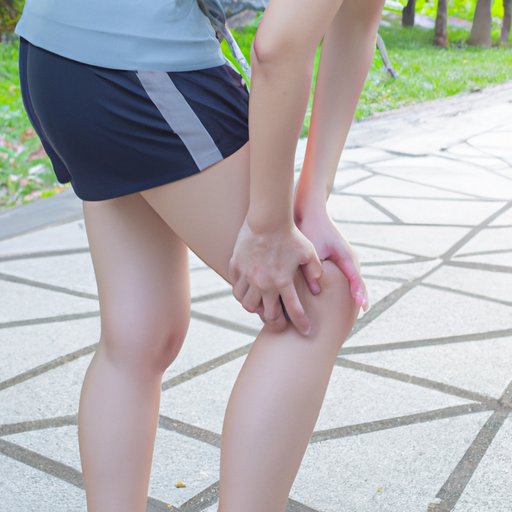Introduction
Menstrual cramps are a common and often debilitating symptom of menstruation. They are caused by strong contractions in the uterus that can cause pain in the lower abdomen, back and legs. While the intensity and duration of cramps vary from person to person, they can be extremely uncomfortable and disruptive to daily life. Fortunately, there are several strategies for managing menstrual cramps, including lifestyle modifications, medications and supplements, and physical activity.

How Working Out Can Help Ease Menstrual Cramps
Exercise is an effective way to reduce the severity of menstrual cramps. Regular physical activity can help to improve circulation, reduce stress, and release endorphins, all of which can help to reduce the pain associated with menstrual cramps. There are several types of exercises that can be beneficial for managing cramps, including aerobic exercises, strength training, and flexibility exercises.
Benefits of Aerobic Exercises
Aerobic exercises such as walking, running, swimming, and cycling can help to reduce the severity of menstrual cramps. These activities increase blood flow to the pelvic area, which helps to relax the muscles in the uterus and reduce the intensity of the contractions. Additionally, aerobic exercises can help to reduce stress and anxiety, which can further reduce pain.
Strength Training and Flexibility Exercises
In addition to aerobic exercises, strength training and flexibility exercises can also be beneficial for managing menstrual cramps. Strength training helps to build muscle, which can provide additional support to the uterus and reduce the intensity of contractions. Additionally, flexibility exercises such as yoga and stretching can help to relax the muscles of the abdomen and pelvis, providing relief from menstrual cramps.

The Role of Exercise in Managing Menstrual Cramps
Exercise can be an effective way to manage menstrual cramps by promoting endorphin release, improving circulation, and altering neurochemical processes.
Endorphin Release
Physical activity increases the release of endorphins, which are hormones that act as natural painkillers. This can help to reduce the intensity of menstrual cramps and provide relief from pain. Endorphins also promote feelings of wellbeing, which can help to reduce stress and anxiety associated with menstruation.
Improved Circulation
Regular physical activity can help to improve circulation throughout the body, including to the pelvic area. This increased blood flow can help to relax the muscles in the uterus, reducing the intensity of contractions and providing relief from pain.
Exploring the Link Between Exercise and Pain Relief During Menstruation
In addition to endorphin release and improved circulation, exercise can also affect the body’s response to pain by altering neurochemical processes. During exercise, the body releases chemicals called neurotransmitters, which can alter the way the brain perceives and responds to pain signals. This can help to reduce the intensity of menstrual cramps.
The Role of Hormones
Hormones can also play a role in the link between exercise and pain relief. During exercise, the body releases hormones such as cortisol and adrenaline, which can reduce inflammation and help to reduce pain. Additionally, some studies have found that regular physical activity can reduce levels of prostaglandins, which are hormones that can cause uterine contractions and contribute to menstrual cramps.

Examining the Impact of Physical Activity on Menstrual Cramp Severity
Regular physical activity can have both long-term and short-term effects on menstrual cramp severity. In the long term, regular exercise can help to reduce the frequency and intensity of menstrual cramps. In the short term, physical activity can provide immediate relief from pain during menstruation.
Long-Term Effects
Studies have shown that regular physical activity can reduce the frequency and intensity of menstrual cramps over time. Regular exercise can help to strengthen the muscles of the abdomen and pelvis, which can provide additional support to the uterus and reduce the intensity of contractions. Additionally, regular physical activity can help to reduce stress and anxiety, which can further reduce pain.
Short-Term Effects
In the short term, physical activity can provide immediate relief from menstrual cramps. Exercise helps to increase blood flow to the pelvic area, which can help to relax the muscles in the uterus and reduce the intensity of contractions. Additionally, exercise can help to promote endorphin release, which can provide natural pain relief.
Conclusion
Menstrual cramps can be a debilitating symptom of menstruation, but there are several strategies for managing them. Exercise is an effective way to reduce the severity of menstrual cramps, as it can help to reduce pain through endorphin release, improved circulation, and neurochemical changes. Regular physical activity can have both long-term and short-term effects on menstrual cramp severity, providing both immediate and long-term relief from pain. Further research is needed to explore the exact mechanisms by which exercise provides relief from menstrual cramps.
(Note: Is this article not meeting your expectations? Do you have knowledge or insights to share? Unlock new opportunities and expand your reach by joining our authors team. Click Registration to join us and share your expertise with our readers.)
